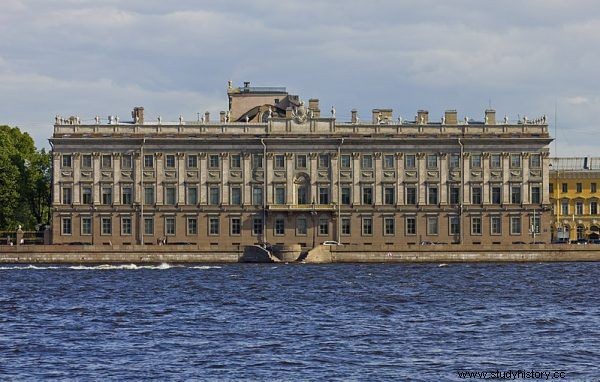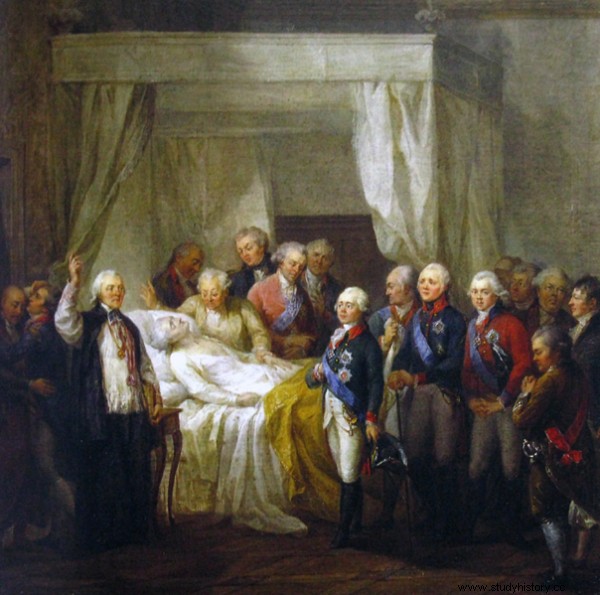After losing the crown, Stanisław August Poniatowski moved to Russia. He led a high-quality life there. He was treated with the respect due to the ruling monarch. However, nothing could soothe the broken heart of a Pole ...
After the fall of the Kościuszko Uprising, it became clear that the days of the Commonwealth were numbered. Power was slipping from the hands of the king, and the Russian army became the real rulers in Warsaw. Catherine II demanded that Poniatowski leave the capital and live in Grodno as a prisoner of state.
The king left Warsaw on January 7, 1795. The journey was quite comfortable: on the orders of Catherine II, 80 horses with a harness were waiting for the king at each station and post offices were prepared for his arrival should he wish to take a break from his journey. On January 12, Stanisław August entered Grodno, and General-Governor Nikolai Riepnin welcomed him with military honors. In accordance with the wishes of the Russian Tsarina, Poniatowski was to be treated with the respect due to the ruling monarch. The Russians were to call him "Your Majesty."
Luxurious in Grodno
Stanisław August settled in the castle in Grodno, renovated on his arrival. His manor house consisted of over 150 people, dragoons stood guard at the entrance to the building and in the hallways to guard the security. The former king was provided with his favorite pastime - billiards. After a few weeks, Stanisław August was visited by his relatives, including his sister, his long-time lover, General Grabowska, nephews and illegitimate sons. On Riepnin's orders, a theater was set up in the old spinning mill, which housed a royal box and a buffet.

Elżbieta Grabowska
Poniatowski's living conditions were almost luxurious, but in fact he lived in a golden cage :He could not dispose of his life, and every visitor to the castle was subject to a personal search. Besides, the king was worried about the future of his homeland. Although the final partition of Poland had already taken place (on October 24, 1795 Russia, Prussia and Austria had signed the relevant treaty), the monarch was under the illusion that not everything was lost for his country and was reluctant to sign the abdication. When he became aware of his hopes and on November 25, 1795, he renounced the crown.
The fate of Stanisław August changed after the death of the powerful empress in November 1796, when the new ruler - Paul I - wrote him a handwritten (!) Letter, inviting the former king to live in St. Petersburg. I feel happy - he wrote - to be able to offer you to come and live in my permanent residence [...] where I will try to do everything to create a pleasant stay for him and to give him everything that is due to him ".
Honors in St. Petersburg
On March 10, 1797, Poniatowski reached the borders of the capital, where the tsarist sons Aleksander and Konstanty were waiting for him. With their assistance, the monarch went to his St. Petersburg seat - the Marble Palace.
At the gate of the building, the emperor himself was waiting for the king, who brought him into the palace and spent an hour alone with him. The next day, the Pole ate dinner at the Winter Palace. At the request of Paul I, after a few days Poniatowski was introduced to the diplomats accredited to the Russian court, which meant that Stanisław August was treated not as a former, but as a reigning monarch. The Emperor made his palace on Stone Island at his disposal during the holidays.

The Marble Palace, the residence of the dethroned Stanisław August in St. Petersburg.
Soon the king began to accompany the tsar on trips to the residences in Pavlovsk, Peterhof and Tsarskoye Selo. The Polish residence in St. Petersburg has become a meeting place not only for the local Polish diaspora, but also for the capital society and foreign diplomats. The parties at the Marble Palace were famous for their exquisite cuisine, and the Russian nobility dreamed of inviting the former king to dinner. The Russians tried to please the palate of the Polish monarch, importing at his request flour from ... marymont mills, because Poniatowski claimed that high-quality flour can only be found in his homeland.
In April 1797, Stanisław August was the guest of honor at the coronation of Paul I in Moscow. There he was given a palace guarded by the imperial bodyguards at his disposal. During the ceremony, Poniatowski wore a purple velvet cloak with an ermine lining, i.e. the garb worn by monarchs. At the coronation feasts, he always sat between Paul I and his wife Maria Fedorovna.
Mourning at the tsarist court
Although Stanisław August lived a very comfortable life in St. Petersburg, his health was deteriorating, which was due to worry about enormous debts. On the morning of February 11, 1798, he had a seizure of apoplexy. In the afternoon, Paweł I appeared at the Marble Palace and began asking doctors about the health condition of the Pole. "There was great confusion on the tsar's face, combined with the most sincere regret," recalled the witness to the events. The imperial sons Aleksander and Konstanty and members of the diplomatic corps also arrived. At 8.00 p.m., the papal nuncio Lorenzo Litta absolved the unconscious Poniatowski, and at dawn on February 12, the monarch gave his last breath.
The body of Stanisław August, embalmed and dressed in the uniform of the Crown Guard, girded with a blue ribbon with the Order of the White Eagle, rested in the royal bedroom for ten days. The Imperial Guard was on guard around him. Subsequently, Paul I and his sons transferred the monarch's coffin to the Throne Room of the Marble Palace, where the body was exposed to the public. Paul I personally put the crown on the head of the deceased. From that moment on, there was a four-week mourning at the court of the Romanovs.

Death of Stanisław August Poniatowski
Poniatowski's remains were to be buried in the Church of St. Catherine. During the transfer of his coffin, 18,000 soldiers stood on the route, and Paweł I himself led the procession. a great gilded metal coffin. The Emperor had the following inscription on the tombstone:
St. II August
King of Poland, Grand Duke of Lithuania
a telling example of the volatility of luck
reasonably prosperous, valiantly endured the opposite
died in St. Petersburg on February 1, 1798
at 66
Paul I the Self-Lord
and the Emperor of All Russia
friend and visitor
will put
